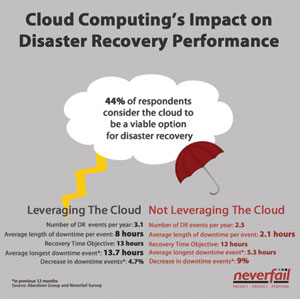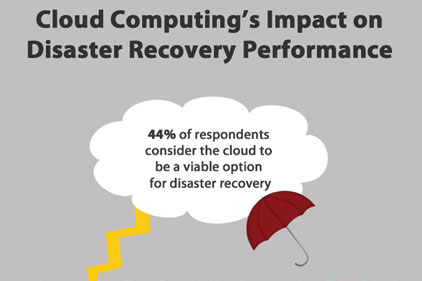
|
|
Cloud computing will have significant impact on disaster recovery performance. Image courtesy of Neverfail Group |
And then found. Among the cameras, servers, alarms, readers, smart cards and other dazzlers at last month’s ISC West in Las Vegas, the technology-centric security trade show, a reasonably new face appeared, seemingly out of thin air. Call it cloud computing or hosted services or remote managed services or software as a service or video as a service.
Whatever it’s called, there is no doubt that the essential elements are the Internet and a Web browser.
Generally speaking, cloud computing is computation, software, data access and storage services that do not require end user knowledge of the physical location and configuration of the system that delivers the services.
On-Demand Model
It also describes a new model for security services based on Internet protocols for enabling convenient, on-demand network access to a shared pool of configurable computing resources – networks, servers, storage, applications, and services – that can be rapidly provisioned and released with minimal management effort or service provider interaction.
“Cloud computing represents a major shift in the evolution of the Internet, and as more customers migrate from traditional IT infrastructures, the need for rapid self-provisioning and efficient management becomes increasingly critical,” contends Parvesh Sethi, senior vice president of Cisco’s Advance Services organization.
Today, there is a growing number of security firms offering cloud services, from pioneer Brivo Systems and Westec to traditional alarm monitoring firms and integrators such as Niscayah. Mass notification systems at colleges and schools often are in the cloud with students and staff enrolling themselves through the Web.
Security video also is moving into the air with monitoring thanks to IP cameras and encoders, video verification of alarms, and storage and retrieval of video for forensics.
Another emerging security use of the cloud is very down to earth: as part of disaster recovery plans and practices. Still, a recent study also shows how the cloud has a (shall we say) “cloudy” side to it. Neverfail, a global software company, surveyed IT professionals, finding that the cloud is perceived by nearly half to be a viable option for disaster recovery; however, many have yet to overcome security and reliability concerns. For those who do not consider the cloud to be viable for disaster recovery, the majority (34 percent) say it is due to their lack of confidence in cloud security.
On the upside, there is now growth in spending for new technology by enterprises.
IT and security continue to show strong signs of growth as budgets, cloud use, virtualization adoption, and staffing plans showed their strongest gains in more than 18 months, according to a new report by Spiceworks, the social business network. Cloud services are now used by 28 percent of businesses, a 100 percent growth rate from mid-year 2010.
At the same time, there is some concern about the ability of the Internet to handle increased business demand.
More Traffic, More Headaches
Two-thirds of businesses say they need to increase their Internet bandwidth in the next 12 months to keep pace with business needs, signaling rising bandwidth demand that will test the current limits of broadband subscriptions, according to a survey by Altman Vilandrie & Company, a consultant firm. “Clearly businesses are hungry for more bandwidth,” says the firm’s Stefan Bewley. Adopting new technology applications, such as cloud-based services, was the most commonly identified reason for the bandwidth upgrades, and was more than twice as common as any other single factor.
The future in the cloud? Sure, for some; but it’s only another step along the way.
All of this reminds me of the time that Rear Admiral Grace Murray Hopper took me on a personal tour of the computer gems at the Smithsonian, including the Mark II “calculator,” a first kind of computer built when I was born in 1947. She then told me about a moth that flew into the device to die and become the first computer bug.
For enterprise security leaders, there are more bugs to come, in the cloud and on the ground. It should be worth it.




